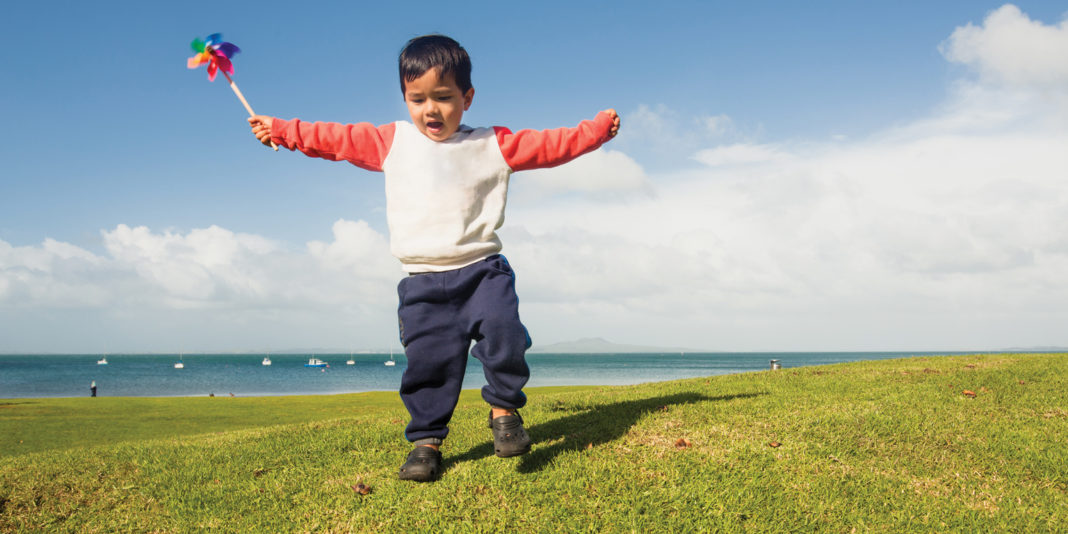It was the grins of kids who were once covered in school sores that showed district nurse Sandra Innes-Smith the team was on the right track.
Giving out plasters, soap and antiseptic cream, along with friendly, repeated advice, is part of a nurse-led project in schools in the Eastern Bay of Plenty town of Kawerau that’s making a major difference to skin infections in children.
The Kiri Ora Healthy Skin project is one of the initiatives prompted by the region’s public health service, Toi Te Ora, after concern at the start of the decade at the high number of children being admitted to Bay of Plenty DHB hospitals with preventable skin infections – from infected scabies to eczema and nappy rash to cellulitis.
The DHB’s serious skin infection rates peaked at more than 80 per 10,000 children in 2009–10, far above the national average and costing the DHB more than $1 million a year, not to mention the trauma for the children and families involved. The rate was much higher for the region’s Māori children – 140 per 10,000 children – again much higher than the national average for Māori, raising issues over equity, poverty and access to health care, in particular some of the region’s rural towns and communities.
Having arrived from Scotland only a few years previously, where rheumatic fever was virtually unknown and skin infections like impetigo (school sores) rare, the region’s statistics in both were worrying for Dr Jim Miller, a Toi Te Ora medical officer of health.
In 2011 Toi Te Ora communicable disease nurse Lindsay Lowe and colleagues carried out a skin infection health needs assessment, which confirmed that serious skin admissions were on the rise in the region. James Scarfe, a Toi Te Ora public health analyst, says research in neighbouring Gisborne also indicated that the hospitalisation statistics were the tip of the iceberg, with for every child hospitalised around 14 cases of skin infections being seen by general practices.
The public health team set in place a range of strategies to meet its goal of reducing the human and financial cost of child serious skin admissions by two-thirds in five years. It is not there yet, but the latest Bay of Plenty statistics available (from 2015–16) show the rate dropping from the peak of 80 in 2009–10 to 54 per 10,000 children – the lowest this century.
In addition, the rate for Eastern Bay Māori, the region’s highest, dropped from more than 160 to 100 over the same time period. Part of that success story is the Kiri Ora project launched and led by Sandra Innes-Smith.
Plasters a ‘luxury’
When talking to mums about their children’s impetigo, it became increasingly clear to district nurse Innes-Smith that for many homes a box of plasters is a luxury.
“I know these are really good mums but their budgets are just zero,” she says. She would be sharing clean-skin messages with these mums and realise that buying even basic products like plasters was beyond their budgets.
So when Toi Te Ora set a goal of reducing skin infections she was adamant that equally important as educating parents and kids was providing basic skin care resources to families in need, so they could put the education into action.
Toi Te Ora were in agreement and the DHB’s planning and funding manager came on board to fund healthy skin packs – built on a Wellington Regional Public Health initiative. Inside the pack is soap, plasters, chlorhexidine wipes, toothbrushes, nail clippers, nit combs and family-friendly health information.
The region’s skin packs have played a key role in the Kiri Ora project since Innes-Smith first carried out her pilot skin clinic in Kawerau schools back in 2014, with the support of Lizzie Farrell, the public health nurse leader for the Wiri School skin clinic programme that inspired the Mana Kidz programme in South Auckland schools.
The pilot built on the Eastern Bay of Plenty Primary Health Alliance’s Rheumatic Fever Prevention project, which Innes-Smith is clinical lead for, with the twice a week nurse-led skin clinics at each school coinciding with the throat swabbing team visits. A successful pilot evaluation led to a nurse being funded to continue the project which has since expanded from the original primary schools in the Kawerau area to include schools in Edgecumbe and Whakatane, bringing the number of schools to 10 and the children under the programme to about 2,000.
Some of the first children Innes-Smith saw at the pilot school clinics had got used to managing their scrapes, grazes and bites without plasters. She says it was matter of some friendly retraining that if they got a scab or sore they needed to clean it and cover it with a fresh plaster every day rather than just pulling their jersey down to hide it. They were then sent home with plasters and maybe cleansing wipes and antiseptic cream too – while the full skin packs are only given out once or twice a year, the project makes sure that no child leaves a clinic with simply advice, but also with the products they may not have at home to help them heal without infection. If a sore requires antibiotics, the clinic nurse refers and works with local general practices to ensure the child gets a prescription and follows up with the family.
Clean, cut, cover and check
The Toi Te Ora clean skin key message consistently delivered to all children and families across the DHB is “clean, cut, cover and check” – or clean hands and nails regularly, keep nails cut to avoid scratching, wash and cover any sores and cuts with plasters, and check sores and seek help if they don’t get better, increase in size or have pus or red streaks coming from them.
Friendly and fun repetition of the message is essential, says Innes-Smith, as once is never enough for children. So nurses will praise and endorse the child who returns to the school clinic with a clean wound covered with a fresh dressing, but they will also give a warm welcome to the child who returns with an open wound that’s still struggling and happily talk them through the message once more.
“What they learn is that we really like seeing them, we’re really friendly and we will give them positive reinforcement when they do ‘get’ it.”
Sometimes the project’s clinic nurse has had to battle for a month or two to heal kids who arrived with as many as 10 infected school sores and new ones still popping up. Until comes the day the kid knows to return with just a single wound – a fairly minor school sore – at just the right time to be treated before it cascades and the nightmare starts all over again. “With lots of positive reinforcement the kids really, really do learn how to nip things in the bud,” says Innes-Smith.
“I can hardly express how amazing it is when kids come back proud as Punch of how they’ve managed their own scrape, scratch or sore,” says Innes-Smith. “They know they’ve done the right thing and they are just grinning from ear to ear. That’s when you know you’ve really cracked it.”
She stresses again that she believes education is not enough on its own for financially struggling families. “It was disempowering them not to provide product (like plasters, wipes and creams), she says. “If you just provided words all you were going to do was make them feel guilty.” And kids respect their product – telling her it has a special place in their drawer or the fridge.
The potential link between skin infections and acute rheumatic fever is also another motivation for Innes-Smith for bringing home the clean skin message. “Even if there’s not a direct pathway between skin infection and acute rheumatic fever, at least if you are not carrying strep bacteria on your skin it’s got to be a win,” she believes.
Innes-Smith would also dearly love to be able to expand the skin clinics to kohanga reo and to more schools – particularly in the Opotiki area – but skin packs are distributed to children via other schools and early childhood centres in the throat-swabbing programme and the team works closely with the public health nurse team. She says on average the area is giving out nearly 40 skin packs of various types a day.
Toi Te Ora strategies
Catching and treating more skin infections in the community – like the Kiri Ora project does – before they became so serious children needed hospitalisation was a major aim of Toi Te Ora’s serious skin infection prevention and education strategies.
Jim Miller said Toi Te Ora’s statistics focused on serious infections that ended up in hospital as those were the infections the DHB could count but they also gave an indication for child skin infections across the wider community. “You are never going to get rid of all serious skin infections – but a lot we were seeing were quite clearly preventable by good hygiene and skin care and should be easily managed in the community.”
Lindsay Lowe said one of their three key strategies was on increasing awareness and understanding in the community about skin infection prevention and management. “Some people didn’t even recognise it as a problem,” says Lowe.
Children were turning up at schools with infected sores and while it fell short of being considered normal it was getting to the point of being too accepted. Toi Te Ora adapted Wellington public health resources to promote and share the healthy skin messages with parents, whānau and early childhood centre staff along with the skin packs.
The second strategy was focused on health professionals – and Toi Te Ora held a series of workshops to highlight not only the local health burden of serious skin infections but also increase the skills and responsiveness of nurses and GPs when they saw children with skin infections.
The third strategy was to improve the effectiveness of primary and community health services in preventing and managing skin infections including promoting the use of community pharmacies, developing closer collaborations between providers, continuing to provide skin packs to high incident communities and focusing interventions on those highlighted at most risk from their analysis, which were babies and Māori children aged up to four years in particular. (The high baby statistics were thought to be partly due to the lower threshold for admitting babies to hospital with infections that included infected eczema, insect bites and nappy rash.)
Reducing serious child skin infections is to date the most successful of the three child infection reduction goals set by Toi Te Ora in 2012 along with rheumatic fever and respiratory infections. All three are often linked through the underlying factors of poverty and deprivation with families living in overcrowded conditions in often damp and cold houses more at risk. With progress in reducing respiratory and rheumatic fever more mixed Miller says Toi Te Ora is also trying to support housing initiatives that can help reduce some of those risks.
Meanwhile, with kids in Kawerau treasuring their plaster packs, and families and health professionals getting the clean skin message, it looks like reducing skin infections is on track for a start.





















